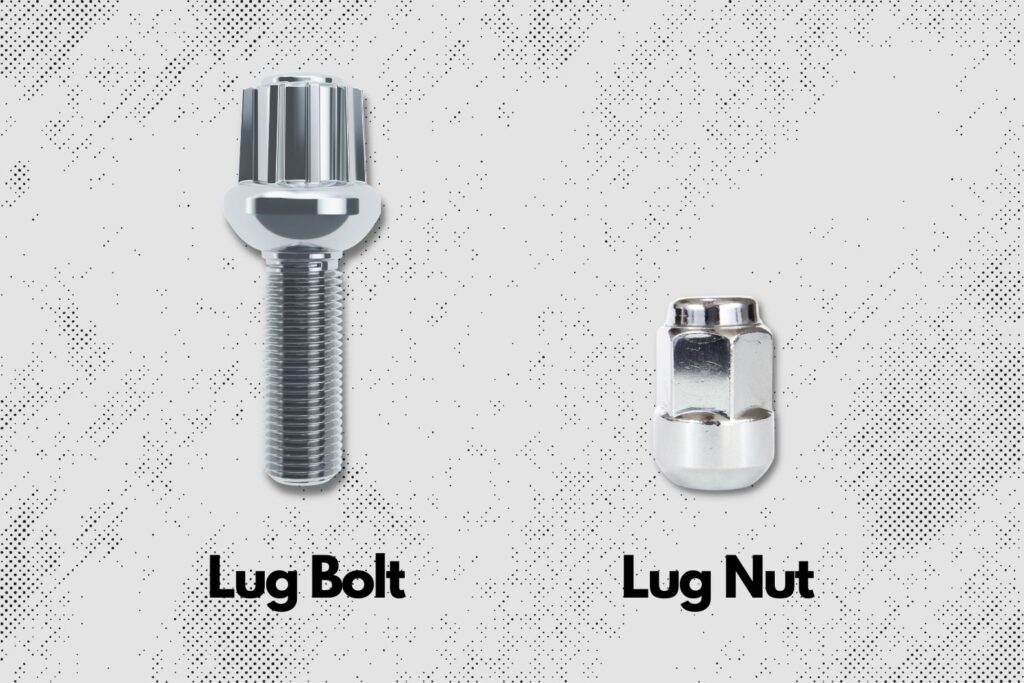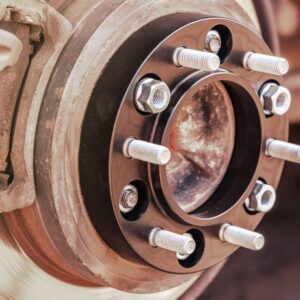What kind of fastener keeps the wheels fixed to your vehicle? Most wheels use either lug bolts or lug nuts. They perform the same job but are different enough to prevent you from swapping between them unless you replace the entire wheel. You can’t fit lug bolts on wheels and hubs designed for lug nuts and vice versa. Since you might replace a wheel as part of a repair job or upgrade all four wheels, knowing the difference between a lug bolt and a lug nut can prove helpful.
Pros and Cons of Lug Bolts vs. Lug Nuts
If you plan to replace the wheels, you might also want to change the type of fasteners that attach them to your vehicle’s wheel hubs.
When choosing between lug bolts and lug nuts, take a look at the following factors:
Durability
If you aren’t careful while working with lug bolts, you might damage the threaded studs or the bolt holes. It’s difficult enough to replace a lug bolt with damaged threading. A damaged bolt hole necessitates replacing the entire wheel hub, which can cost a considerable sum and take up valuable time.
It’s also possible to damage the threading of a lug nut by accident. You must always handle these parts with care.
Ease of Use
If you want a convenient installation process, choose wheels with lug nuts. They’re easier to remove and install than wheels that use lug bolts.
When you install a wheel with lug bolts, you must line up the bolt holes on the part with those on the hub. Otherwise, the lug bolt can’t pass through both sets of holes, preventing the fastener from securing the wheel to the vehicle.
Furthermore, you must hold the wheel in place while inserting the lug bolts. It takes several successfully threaded lug bolts to support the part’s considerable weight and prevent it from moving or falling.
When compared to the effort required to work with lug bolts, removing and installing a wheel with lug nuts takes less effort. You can hang the wheel on the studs and leave it in place.
Security
Are you worried about thieves stealing wheels in your neighborhood? Lug bolts offer better security than lug nuts because unfastening bolts takes more time and effort than the typical thief is willing to take.
In most cases, thieves will go for easy thefts. The longer they take to steal something, the higher the chance they might make a mistake and get discovered. Therefore, a wheel with lug bolts is a less attractive target for thieves.

What Is a Lug Bolt?
Lug bolts are fasteners that secure the wheel to the hub. They consist of a threaded stem, a tapered head, and the eponymous bolt that connects the two components.
Vehicles that use lug bolts dispense with the need for wheel studs. Their wheels might directly attach to their wheel hubs. You might also find their brake rotors on their hubs.
You use a socket wrench to tighten lug bolts. Many European vehicles use wheels with lug bolts.

What Is a Lug Nut?
Also called a wheel nut, a lug nut is a threaded fastener that fixes the wheel to the vehicle. It screws onto the wheel stud mounted on the vehicle’s hub.
The typical wheel has either four or five lug nuts. You can tighten them with a wrench of the appropriate size.
American vehicles often use wheels with lug nuts. So do models manufactured by Asian companies like Toyota and Honda.
Lug Nut Types
Over the decades, manufacturers have developed different kinds of lug nuts to meet various requirements. Here are some of the most common types of lug nuts:
Hex Nuts
Hex nuts feature a head with six sides. Like other lug nuts, their head threads onto the wheel stud to ensure the wheel stays locked and doesn’t move or grow loose.
Most hex nuts are steel with chrome plating for protection against corrosion. There are also aluminum and titanium hex nuts that offer similar or superior durability, better resistance to corrosion, and reduced weight.
Conical Seat Lug Nuts
Conical seat lug nuts feature a lug seat with tapering sides. Their conical shape leads to people referring to them as acorn lug nuts or tapered lug nuts.
The lug seat sets the meeting point between the lug nut and the wheel. In a conical seat nut, the component tapers at an angle of either 45 degrees or 60 degrees.
When you tighten conical seat nuts, they help center the wheel. Vehicles with centered wheels enjoy better stability on the road.
Thanks to their high performance, conical seat lug nuts are usually used in high-performance vehicles at motorsport events.
Open-Ended Lug Nuts
An open-ended lug nut has openings on either end. The threaded stem passes through the entire length of the fastener.
Open-ended nuts can accept wheel studs that are longer than the ones used by other lug nut designs.
Race cars often use open-ended lug nuts to secure their wheels.
Tuner Lug Nuts
Tuner lug nuts have tapered seat lugs that are smaller than other lug nuts. Their conical shape is a security feature that prevents anyone from working on them unless you use a tool called a key that can remove them.
Each key can only remove and install the corresponding tuner lug nut. A key that works for one tuner nut design won’t work for a different nut.
Tuner nuts can reduce the risk of thieves stealing your vehicle’s wheels. Some designs can reduce the risk of a lug nut getting stripped and damaged by enabling additional torque.
Losing a key will force you to get a replacement from the dealership or manufacturer of the tuner lug nuts. Otherwise, you risk damaging the lug nuts if you forcibly remove them, and you’ll require replacements for the damaged parts as soon as possible.
Other Types of Lug Nuts
Other types of lug nuts are the following:
- Spherical lug nuts
- Flat seat lug nuts
- Mag seat lug nuts
- Extended thread lug nuts
- Spline drive lug nuts
- Flange lug nuts
- Double-sided lug nuts
- Left-hand threaded lug nuts
Lug bolts and lug nuts offer advantages and disadvantages. Evaluate them according to your specific needs and choose the one that best suits your vehicle and what you want to do with it.
Get New Lug Nuts and Bolts That Fit Your Vehicle
Getting the right kind of fasteners is just as important as getting the right kind of wheels for your vehicle. You can’t just choose a random one, or you might end up with poorly fitted wheels that can suddenly come off while driving. For your own safety, you’ll have to choose fasteners that perfectly fit your wheels. Luckily, whether you’re looking for lug nuts or lug bolts, you’re sure to find the right ones at CarParts.com.
CarParts.com offers a wide selection of lug nuts and lug bolts that are sourced from only the most trusted manufacturers in the industry. Shop with confidence by checking each of our products’ accurate and detailed fitment information to get parts that fit. Just in case you aren’t completely satisfied with your order, we also accept returns within 60 days of purchase. Just reach out to our customer support staff, and they’ll be happy to assist you with your order.
Don’t settle for anything less than high-quality fasteners, so you can confidently drive your car knowing that your wheels are secure. Check out our catalog of high-quality lug nuts and lug bolts at CarParts.com and get one today!
Any information provided on this Website is for informational purposes only and is not intended to replace consultation with a professional mechanic. The accuracy and timeliness of the information may change from the time of publication.
































